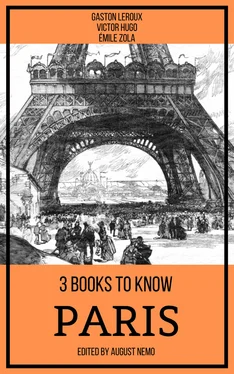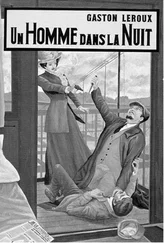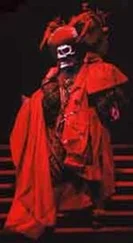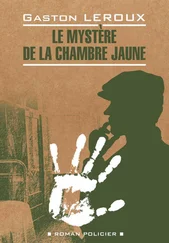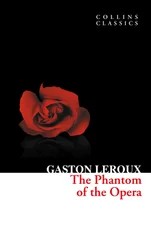Nevertheless, all was over for the poor cardinal, and he was obliged to quaff to the dregs the bitter cup of being in such b.ad company.
The reader has, probably, not forgotten the impudent beggar who had been clinging fast to the fringes of the cardinal’s gallery ever since the beginning of the prologue. The arrival of the illustrious guests had by no means caused him to relax his hold, and, while the prelates and ambassadors were packing themselves into the stalls—like genuine Flemish herrings—he settled himself at his ease, and boldly crossed his legs on the architrave. The insolence of this proceeding was extraordinary, yet no one noticed it at first, the attention of all being directed elsewhere. He, on his side, perceived nothing that was going on in the hall; he wagged his head with the unconcern of a Neapolitan, repeating from time to time, amid the clamor, as from a mechanical habit, “Charity, please!” And, assuredly, he was, out of all those present, the only one who had not deigned to turn his head at the altercation between Coppenole and the usher. Now, chance ordained that the master hosier of Ghent, with whom the people were already in lively sympathy, and upon whom all eyes were riveted—should come and seat himself in the front row of the gallery, directly above the mendicant; and people were not a little amazed to see the Flemish ambassador, on concluding his inspection of the knave thus placed beneath his eyes, bestow a friendly tap on that ragged shoulder. The beggar turned round; there was surprise, recognition, a lighting up of the two countenances, and so forth; then, without paying the slightest heed in the world to the spectators, the hosier and the wretched being began to converse in a low tone, holding each other’s hands, in the meantime, while the rags of Clopin Trouillefou, spread out upon the cloth of gold of the dais, produced the effect of a caterpillar on an orange.
The novelty of this singular scene excited such a murmur of mirth and gayety in the hall, that the cardinal was not slow to perceive it; he half bent forward, and, as from the point where he was placed he could catch only an imperfect view of Trouillerfou’s ignominious doublet, he very naturally imagined that the mendicant was asking alms, and, disgusted with his audacity, he exclaimed: “Bailiff of the Courts, toss me that knave into the river!”
“Cross of God! monseigneur the cardinal,” said Coppenole, without quitting Clopin’s hand, “he’s a friend of mine.”
“Good! good!” shouted the populace. From that moment, Master Coppenole enjoyed in Paris as in Ghent, “great favor with the people; for men of that sort do enjoy it,” says Philippe de Comines, “when they are thus disorderly.” The cardinal bit his lips. He bent towards his neighbor, the Abbé of Saint Geneviéve, and said to him in a low tone,—“Fine ambassadors monsieur the archduke sends here, to announce to us Madame Marguerite!”
“Your eminence,” replied the abbé, “wastes your politeness on these Flemish swine. Margaritas ante porcos, pearls before swine.”
“Say rather,” retorted the cardinal, with a smile, “Porcos ante Margaritam, swine before the pearl.”
The whole little court in cassocks went into ecstacies over this play upon words. The cardinal felt a little relieved; he was quits with Coppenole, he also had had his jest applauded.
Now, will those of our readers who possess the power of generalizing an image or an idea, as the expression runs in the style of to-day, permit us to ask them if they have formed a very clear conception of the spectacle presented at this moment, upon which we have arrested their attention, by the vast parallelogram of the grand hall of the palace.
In the middle of the hall, backed against the western wall, a large and magnificent gallery draped with cloth of gold, into which enter in procession, through a small, arched door, grave personages, announced successively by the shrill voice of an usher. On the front benches were already a number of venerable figures, muffled in ermine, velvet, and scarlet. Around the dais—which remains silent and dignified—below, opposite, everywhere, a great crowd and a great murmur. Thousands of glances directed by the people on each face upon the dais, a thousand whispers over each name. Certainly, the spectacle is curious, and well deserves the attention of the spectators. But yonder, quite at the end, what is that sort of trestle work with four motley puppets upon it, and more below? Who is that man beside the trestle, with a black doublet and a pale face? Alas! my dear reader, it is Pierre Gringoire and his prologue.
We have all forgotten him completely.
This is precisely what he feared.
From the moment of the cardinal’s entrance, Gringoire had never ceased to tremble for the safety of his prologue. At first he had enjoined the actors, who had stopped in suspense, to continue, and to raise their voices; then, perceiving that no one was listening, he had stopped them; and, during the entire quarter of an hour that the interruption lasted, he had not ceased to stamp, to flounce about, to appeal to Gisquette and Liénarde, and to urge his neighbors to the continuance of the prologue; all in vain. No one quitted the cardinal, the embassy, and the gallery—sole centre of this vast circle of visual rays. We must also believe, and we say it with regret, that the prologue had begun slightly to weary the audience at the moment when his eminence had arrived, and created a diversion in so terrible a fashion. After all, on the gallery as well as on the marble table, the spectacle was the same: the conflict of Labor and Clergy, of Nobility and Merchandise. And many people preferred to see them alive, breathing, moving, elbowing each other in flesh and blood, in this Flemish embassy, in this Episcopal court, under the cardinal’s robe, under Coppenole’s jerkin, than painted, decked out, talking in verse, and, so to speak, stuffed beneath the yellow amid white tunics in which Gringoire had so ridiculously clothed them.
Nevertheless, when our poet beheld quiet reestablished to some extent, he devised a stratagem which might have redeemed all.
“Monsieur,” he said, turning towards one of his neighbors, a fine, big man, with a patient face, “suppose we begin again.”
“What?” said his neighbor.
“Hé! the Mystery,” said Gringoire.
“As you like,” returned his neighbor.
This semi-approbation sufficed for Gringoire, and, conducting his own affairs, he began to shout, confounding himself with the crowd as much as possible: “Begin the mystery again! begin again!”
“The devil!” said Joannes de Molendino, “what are they jabbering down yonder, at the end of the hall?” (for Gringoire was making noise enough for four.) “Say, comrades, isn’t that mystery finished? They want to begin it all over again. That’s not fair!”
“No, no!” shouted all the scholars. “Down with the mystery! Down with it!”
But Gringoire had multiplied himself, and only shouted the more vigorously: “Begin again! begin again!”
These clamors attracted the attention of the cardinal.
“Monsieur Bailiff of the Courts,” said he to a tall, black man, placed a few paces from him, “are those knaves in a holy-water vessel, that they make such a hellish noise?”
The bailiff of the courts was a sort of amphibious magistrate, a sort of bat of the judicial order, related to both the rat and the bird, the judge and the soldier.
He approached his eminence, and not without a good deal of fear of the latter’s displeasure, he awkwardly explained to him the seeming disrespect of the audience: that noonday had arrived before his eminence, and that the comedians had been forced to begin without waiting for his eminence.
The cardinal burst into a laugh.
Читать дальше
